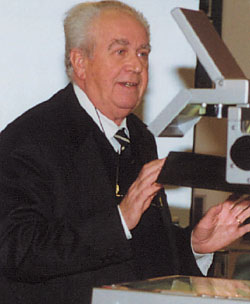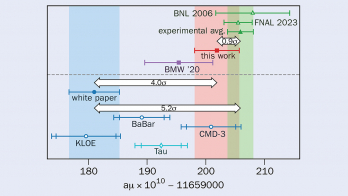In 1960 Bruno Touschek gave a talk on electron-positron collisions that would change the face of physics. Last November, 20 years after his death, physicists gathered to celebrate Touschek’s work.

On 16 November 1998 the INFN Laboratori Nazionali di Frascati celebrated the memory of Bruno Touschek, the spiritual father of electron-positron physics, on the 20th anniversary of his premature death. On the occasion, Frascati announced the institution of the Bruno Touschek grant for high-school students who excel in science.
After escaping from a concentration camp during the Second World War, the Austrian-born Touschek began work in Göttingen and Glasgow, and eventually reached Rome in 1952. On 7 March 1960 he gave a historic seminar at Frascati that would change the face of physics. Pointing out the importance of carrying out a systematic study of electron-positron collisions, he suggested that this could be achieved by constructing a single magnetic ring in which electrons and positrons circulate at the same energy but in opposite directions. Soon afterwards, the first electron-positron accumulation ring, AdA, was built under his leadership in Frascati.
The memorial meeting, held in the main auditorium of the laboratory, named after Touschek, was the occasion for distinguished physicists to review the past, present and future of this still dynamic field of research. After Touschek’s close friends and collaborators, Giorgio Salvini and Carlo Bernardini, recalled his brilliant personality and the “glorious days” of AdA, Jacques Haissinski described the second step of this pioneering work – the move of AdA to Orsay, and the subsequent construction of the ACO ring in that laboratory.

Revolutionary results then flowed from electron-positron rings all over the world. In particular, in the early 1970s electron-positron collisions helped change our view of hadrons (particles that, like the proton and the pion, and unlike the electron, carry the “strong” force) from elementary to composite particles. This was covered by Massimo Testa, who underlined the major role of Adone, Frascati’s second-generation electron-positron machine, in these developments.
Emilio Picasso’s comprehensive review of electron- positron machines, from AdA to the world’s largest ring, LEP at CERN, introduced the present role of electron- positron physics. Guido Altarelli stressed the prominent role of LEP and its US counterpart, Stanford’s SLC, in the detailed confirmation of the Standard Model, our best description of elementary particle interactions so far.
LEP is in the forefront of the search for physics beyond the Standard Model. One hint of such new physics might be the recent results from the SuperKamiokande Collaboration in Japan, looking at neutrinos produced by cosmic rays in the Earth’s atmosphere and which suggest neutrino oscillations. CERN Director-General Luciano Maiani showed why this is so exciting and underlined the importance of conducting accelerator experiments under controlled conditions to explore neutrino masses and mixings. Projects for such experiments are already under way, both in Japan and the USA, but there is still room for Europe to participate in such a venture. The question “Is a meaningful international scientific programme possible?” begs an answer.
For the immediate future, Frascati will again be in the forefront of electron-positron physics with the new DAFNE phi-factory, which obtained its first collisions last March. Miro Preger explained how the machine has already exceeded a luminosity of 1030 per sq.cm per s operating with only one bunch of electrons and one of positrons. In the near future the machine is expected to run with more than 100 bunches per beam to reach the design record luminosity of 5 x 1032.
The reason behind such a high luminosity was explained by Paolo Franzini: it will allow about 5000 phis per second to be produced and will detect their subsequent decays into charged or neutral kaon pairs. Their study should shed light on the long-standing puzzle of the violation of CP symmetry. A new big detector, KLOE, built for this purpose, is a common effort by more than 120 physicists from Italy, Germany, the USA, Russia, China and Israel, and initial results are eagerly awaited.
For the longer term future, the electron-positron community is focusing on projects for a new very-high-energy linear collider, as presented by the final speaker, Marcello Piccolo. Three independent study groups have already addressed this issue in Europe, Japan and the USA. A costed design is expected for 2001; after a selection and approval procedure, construction could start in 2003.
In the new century, Touschek’s ideas will continue to guide our exploration of the fundamental interactions.








